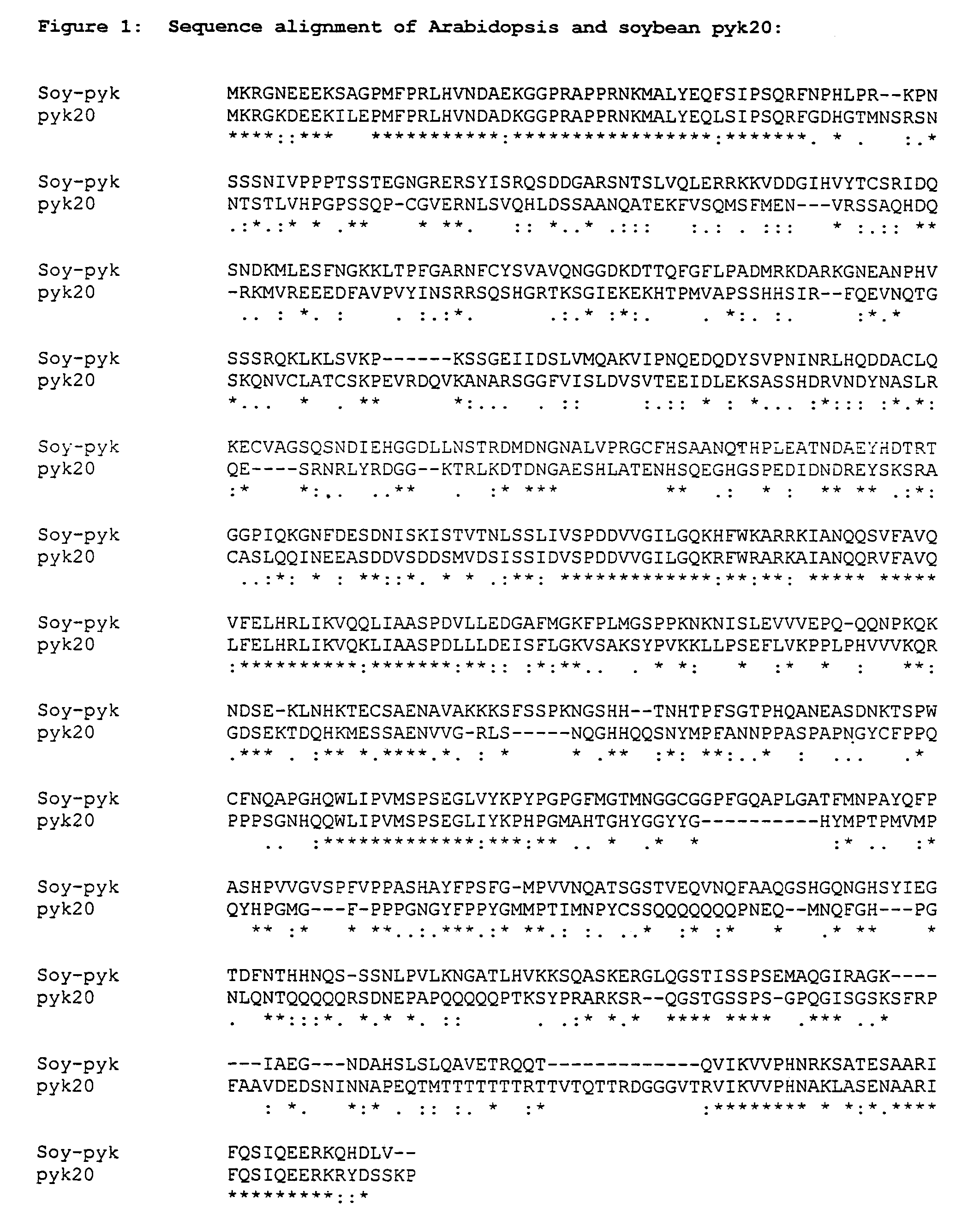Isolated nematode regulated gene promoter and use thereof
a technology of nematode and gene promoter, which is applied in the field of isolated nematode regulated gene promoter, can solve the problems of significant problems such as nematode infection, substantial losses to crops, and undesirable chemical pesticides, and achieve the effect of improving the nematode resistance of plants
- Summary
- Abstract
- Description
- Claims
- Application Information
AI Technical Summary
Benefits of technology
Problems solved by technology
Method used
Image
Examples
example 1
Isolation and Characterization of Pyk20 Gene and Promoter
Materials and Methods
[0171]Soybean plants of cultivars Bell and YB17E were grown in the greenhouse and growth chamber. Plant materials were harvested and ground in liquid nitrogen. Total RNA was isolated from the plant material by the Tri-pure Method (Boehringer) according to the manufacturer's instructions. Genomic DNA was isolated using a DNeasy Plant mini kit (Qiagen) according to the manufacturer's instructions.
[0172]PCRs (polymerase chain reactions) were performed in a total volume of 25 μL in a solution of: 10 mM Tris-HCL, pH 8.3; 1.5 mM MgCl2; 50 mM KCl; 0.1 mM dNTPs; 0.25 μM of each primer, as appropriate; and 0.5 Units of either Advantage cDNA polymerase mix (Clontech) or Pwo DNA polymerase (Boehringer).
[0173]PCR-amplified fragments were analyzed by gel electrophoresis. Fragments of the appropriate molecular weight were individually isolated from the gel and used as the substrate for a second round of PCR amplificatio...
example 2
Expression of GUS Under the Control of the Soybean Pyk20 Promoter in Soybean Hairy Roots
[0180]Agrobacterium rhizogenes strain K599 was used for the soybean hairy root transformation. Stocks of Agrobacterium were maintained on minimal A media (see recipes, below). Plasmid SoyPyk20::GUS (PHP 18280) DNA was introduced into A. rhizogenes strain K599 using the freeze-thaw method, as described in Ha (1988) “Binary Vector” in Plant Molecular Manual, eds. Gelvin, Schilperoort, and Verma, pp. A3 / 1–A3 / 7.
[0181]Soybean seeds were surface-sterilized with chlorine gas at room temperature for 12–16 hours. The seeds were then aerated in a clean air hood for at least 30 minutes. Seeds were germinated and cultured in Magenta™ boxes (Magenta Corporation) containing sterile potting soil with 10 to 15 mL of 25% Gamborg's B-5 Basal medium with minimal organics (G5893, Sigma). The boxes were placed under a mix of fluorescent and incandescent lights providing a 16-hour day / 8-hour night cycle and constant t...
example 3
Expression of GUS Under the Control of the Soybean Pyk20 Promoter in Transgenic Soybean
[0194]The ability of the Soybean Pyk20 promoter to direct the expression of GUS in stably transformed transgenic plants is analyzed. Somatic soybean embryo cultures are transformed, soybean plants are regenerated, and the presence of GUS activity is visualized after submerging the samples in GUS staining buffer and incubating for 16 hours at 37° C. (GUS staining buffer: 0.05% X-Gluc in 100 mM sodium phosphate buffer, pH 7.0, containing 10 mM EDTA, 0.1% Triton, and 0.5 mM K4Fe (CN)6H2O)). The presence of active GUS is indicated by the production of blue color.
[0195]Transformation of Somatic Soybean Embryo Cultures and Regeneration of Soybean Plants.
[0196]Soybean embryogenic suspension cultures are cotransformed with SoyPyk20::GUS and a construct comprising the CaMV 35S promoter operably linked to a gene encoding hygromycin resistance (35S::hygr). Transformations are performed by the method of parti...
PUM
| Property | Measurement | Unit |
|---|---|---|
| pH | aaaaa | aaaaa |
| temperature | aaaaa | aaaaa |
| temperature | aaaaa | aaaaa |
Abstract
Description
Claims
Application Information
 Login to View More
Login to View More - R&D
- Intellectual Property
- Life Sciences
- Materials
- Tech Scout
- Unparalleled Data Quality
- Higher Quality Content
- 60% Fewer Hallucinations
Browse by: Latest US Patents, China's latest patents, Technical Efficacy Thesaurus, Application Domain, Technology Topic, Popular Technical Reports.
© 2025 PatSnap. All rights reserved.Legal|Privacy policy|Modern Slavery Act Transparency Statement|Sitemap|About US| Contact US: help@patsnap.com


